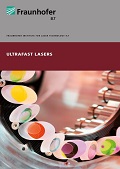The Fraunhofer ILT experts use a broad portfolio of different laser amplifier designs based on Yb-doped crystals; depending on the average power, this includes rod, multi-rod, INNOSLAB and disk amplifiers. The amplifiers are characterized by diffraction-limited beam quality and bandwidth-limited pulse durations. With pulse durations of several 100 fs, the institute’s developments are addressing average powers from 1 W to 10 kW, repetition rates from 10 kHz to 100 MHz and pulse energies from 10 μJ to 10 mJ.
One of Fraunhofer ILT’s core competencies is the INNOSLAB technology that it has developed and patented. With Yb:YAG as the active medium, single-stage (two-stage) output powers > 500 W (> 1000 W) with beam qualities M² ~ 1.10 x 1.40 are achieved at pulse durations of 700 fs. These can be improved by spatial filtering of the output beam to M² ~ 1.10 x 1.10.
As part of the Fraunhofer Cluster of Excellence Advanced Photon Sources CAPS, the output power of these laser sources is to be scaled to over 5 kW.
An essential part of the work is the tailor-made adaptation of the INNOSLAB platform to the requirements of customers from the industry and research in terms of compactness, alignment, long-term stability and special pulse parameters. In addition to INNOSLAB amplifiers, the institute is also adapting other laser platforms such as fiber, rod or disk lasers, which are being combined and further developed to customers’ specifications.

 Fraunhofer Institute for Laser Technology ILT
Fraunhofer Institute for Laser Technology ILT